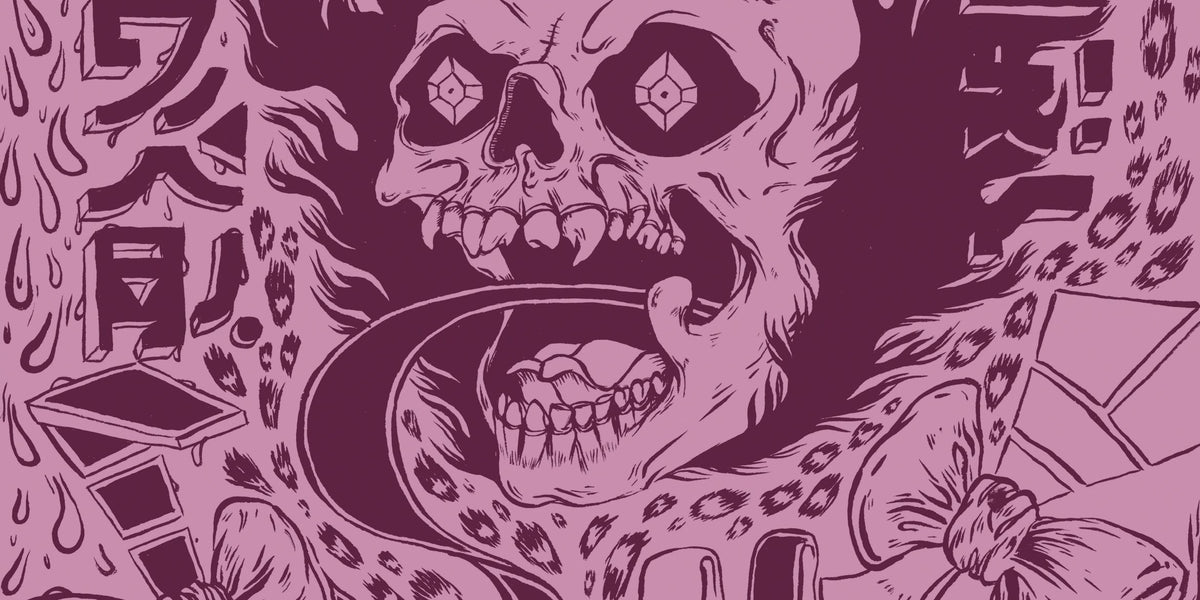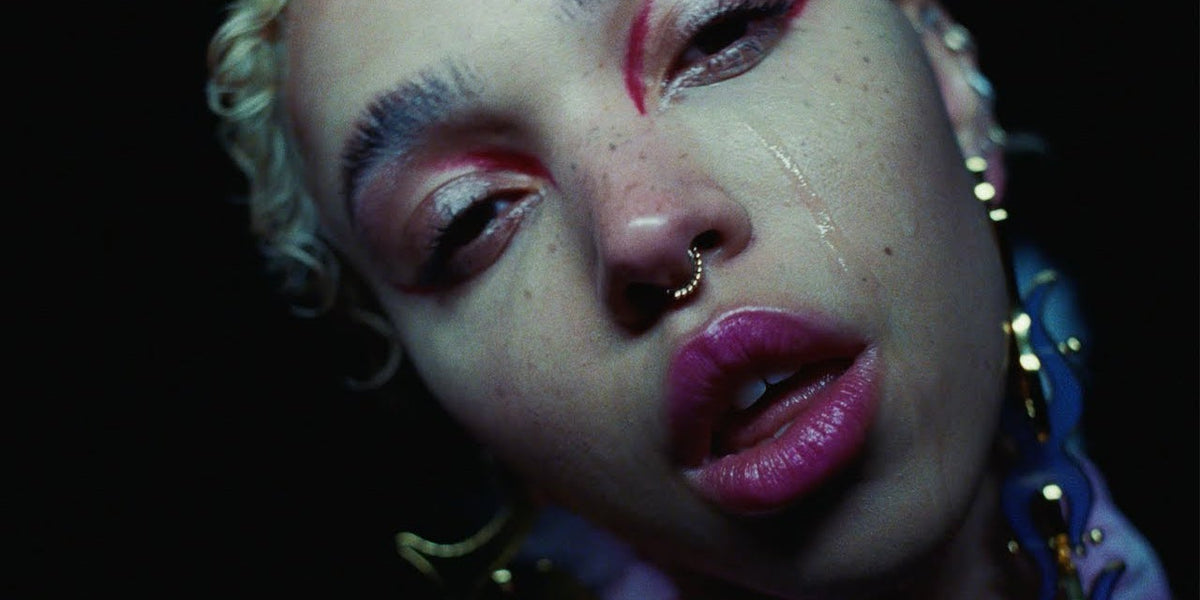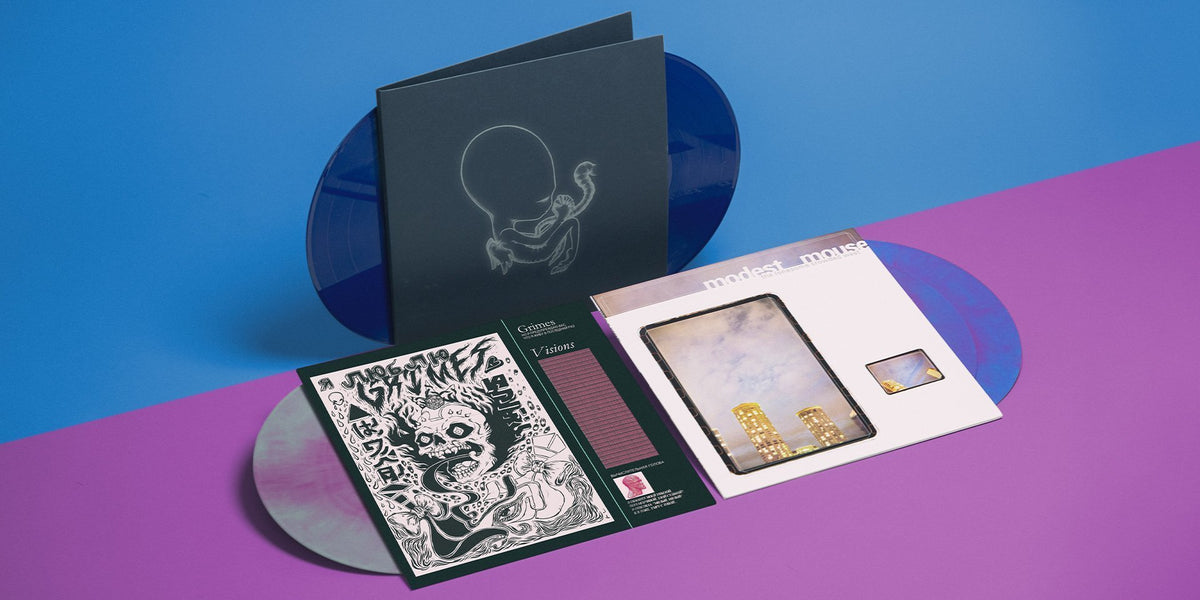‘Visions’ Marked a New Era of Pop Star
Looking back on Grimes’ early impact, in honor of our 10th anniversary reissue
Nobody wants to grow up, but everyone wants to be able to say, “I saw them before they were cool.” If you’re under 25, you can’t say this and be taken seriously; it takes time to go to enough shows and see a lot of bands before one of them blows up, because most bands don’t. Once you can say it, you’re officially old, whether you feel it or not; your culture isn’t dominant anymore and brands stop marketing to you. But in return, you are gifted the priceless experience of seeing an artist on the precipice of fame, untethered by publicists, styling themselves in the green room, taping their own cables down after the opening act. Ten years ago, I saw Grimes before she was cool, playing to a star-struck crowd at the Empty Bottle in Chicago — her ascent has enamored me since, and Visions (2012, 4AD) has become cultural gold.
It was March 14, 2012. I loved her second album Halfaxa (2010, Arbutus); I discovered it on .mp3 blogs (more on that below) and was intrigued by this pixie-like pop musician. Back then, pop stars were still, for the most part, extremely polished, but Grimes had baby bangs and holes in her tights. Even Claire Boucher’s stage name, Grimes, with its root word grime, gave off art student living in an unfinished loft vibes — but less trendy McKibbin Lofts, and more crude spaces with fabric sheets for walls and winter pneumonia outbreaks. By that time, she’d already toured with Lykke Li and Visions had come out just over a month prior, but “Oblivion” wasn’t in commercials yet. She was still a hidden indie curiosity, playing a show in an unassuming rock bar.
For those who’ve never been, the Empty Bottle (prior to its 2020 renovation) is common on the outside, nonchalantly situated in the city’s residential Ukrainian Village neighborhood. A lit black awning reads MUSIC FRIENDLY DANCING in white sans-serif letters, which have become vaunted words for three generations of Chicago’s music fans. Inside, a giant, proudly Midwestern-style wooden bar wraps around the rear floor, serving basic drinks like Old Style in plastic cups. It can ostensibly accommodate a 400-person capacity, but feels way smaller than that. The stage is petite enough that a soloist isn’t swamped by the space. The Flaming Lips, The Strokes and Arcade Fire played there before they were cool. The Empty Bottle is not fancy, but it is beloved.
My ticket was free and I don’t remember why; maybe I won a contest or someone gave me their extra; either way, I was there alone. The sold-out crowd skewed younger, so at 26, I felt out of place; it seemed to be mainly School of the Art Institute of Chicago students with colorful Tumblr accounts. Boucher and her akathisia bounded onto the modest stage with hair in a top ponytail and a long hoodie printed with a heterochromatic cat. She was a nymph in her movement, the way she excitedly unfolded her two keyboard stands, giggling while setting up with the opening act Ultrademon, who was playing her backup electronic drums.
The stands were parallel to each other, so she could play the opening melody of “Genesis” on her Roland Juno-G with one hand, then spin around to trigger samples on a sequencer with the other. As Grimes played the instruments, she cradled a Shure microphone between her cheek and shoulder, the way someone does when they’re talking on the phone hands-free. She’d sing into the mic only when the music was sequenced seamlessly, though you’d never know it — with her frenzied movements, you wondered how she could multitask at all. But her cooing voice was as angelic as it sounded on the album. Boucher self-recorded it in her Montrèal apartment with GarageBand, using the same gear she was playing on stage, so there wasn’t a chasm between the mastered songs and live roughness. At that show, we were treated to the Visions set list that was as close to the recording as possible.
As the music got going, the audience descended into reverie. I stopped feeling old and alone, and threw myself into the twinkling joy of the crowd, we danced our asses off that freezing cold Chicago night; everyone knew the words to “Symphonia IX (My Wait Is U)” and “Oblivion,” even though the album was only six weeks old. Grimes was clearly in her element, and through her chaotic dancing, she bantered with the audience, who adored every moment of her endearing vocal cadence.
I remember thinking that Grimes had it, whatever it is. That undeniable combination of star power, killer aesthetic sense, effortless magnetism and an uncanny ability to look incredible in photographs. Much ink has been spilled trying to distill it into something less nebulous than a look, a feeling, but maybe it’s like porn in that you know it when you see it. Edie Sedgewick had it, Grace Jones had it, Grimes really has it. As I watched her charmingly flit between her electronic instruments and earnest dances, I knew that she was going to be really fucking famous.
The rest is history. Visions blew up like a candy-colored volcano. A decade later, it’s staggering to realize how this album transformed the pop landscape, for the better.
In order to understand Visions’ impact, it’s helpful to look back on its contextually historical debut. In those years, we had fewer ways to seek out new, obscure jams. Spotify and Pandora’s algorithms weren’t yet smart enough to recommend germane artists to listeners, and mainstream music press had only just begun shaking off its aughts reputation for pomposity. In this media dearth, word-of-mouth flourished, in the form of a precious, fleeting phenomenon known as .mp3 blogs. They were typically hosted on Tumblr or Blogspot, and written by enthusiastic, self-important music gurus who existed outside the traditional press cycle. Alongside a short blurb about an artist and an illegally uploaded .mp3 or two, readers felt like they were getting the cool kid scoop from a blogger just like them. And bloggers didn’t care if their daily hits were in the single digits, they were just happy to share weird tunes. It was a great time; I had a personal favorite called 777 And I Am Puking Devil’s Blood, and they sure don’t make website names like that anymore.
.Mp3 blogs didn’t just expose people to new music. In a few cases, entire microgenres were created purely within .mp3 blog discourse. Witch house, debatably an elaborate joke but arguably the most successful, was one such genre. The term was coined by Pictureplane in 2009, as .mp3 blogs (un?)ironically translated Tumblr’s fashion goth aesthetic into hazy electronic music by bands with wingdings in their song titles. With songs like “World ♡ Princess” and “† River †,” Halfaxa is specifically a witch house album, and Boucher wasn’t immune from the trend. Does that make it bad? Absolutely not. Halfaxa still slaps.
But Visions was a quantum leap. Despite the two albums being essentially homemade, Visions is so cohesive, so catchy, that it transcended any trends or pigeonholing that niche press outlets ascribed to it. As .mp3 blogs petered out and its writers were courted (and cannibalized) by mainstream music media, Visions helped shovel dirt onto the grave of microgenres. Today, it’s gauche to invent insidery terms like shitgaze or hypnagogic indie; Visions helped make pop music respectable enough that we can just simply call it pop.
Still, Grimes didn’t look like a conventional pop star. Her references were richly curated like the quirky fashion blogs of the era, because she was a product of the internet and spoke our meme language. She was as shabby as the babe we crushed on who lived in the punk house; her changing hair colors reflected the kaleidoscopic e-girls on our Tumblr feeds. In the way that Kittie’s Spit-era style was the pinnacle of femme mall goth, Grimes was both the arty sprite we knew and wanted to look like. Because she was weird, she gave us weirdos permission to dance and smile.
Not that we needed permission. In the 2010s, the welcome aging-out of Gen X indie pretension meant that subcultures could vociferously, and without fear of in-group rejection, proclaim their love of pop music. In 2012, you could turn on “Gimme More” at any dive, and every millennial cross-section — from goths and punks, to normals and the burgeoning creative class — would bop their head along. But even though we could admit to loving Britney Spears, we didn’t look like her, and we didn’t want to. We loved Grimes because she looked like us. It felt like one of us had made it.
We’re only now appreciating how Grimes broke that barrier. Thanks to the massive success of Visions, pop music wasn’t just a guilty pleasure — it became a respectable creative aspiration for everyone of all subcultural backgrounds. We take for granted that Billie Eilish is a skater goth or that Halsey has a pixie cut, that you can be one of the most famous pop artists on the planet and have a full sleeve of tattoos. And while plenty of her pop predecessors were as weird as she is, Grimes was the first one to become so mainstream that she’s a judge on a Fox reality show. Even my parents know who she is, and that’s saying a lot.
Thus, Visions represented a death knell for two cultural artifacts: music microgenres and polished female pop stars. I’m sure I wasn’t the only one at the Empty Bottle who could sense that she’d become famous, but no one was prepared for how she’d wield a sword in the face of dominant pop culture. Aptly titled, Visions predicted a world where, thanks to the internet, subcultures and the mainstream are beautiful, dazzling shades of one another, as free of boundaries and prescriptions as the crowd that night, following her tidings to be a body.
Meagan Fredette is a freelance writer based in Brooklyn, NY. Her music journalism and criticism have been published by Rolling Stone, Pitchfork, W Magazine, the Village Voice, the Chicago Reader, Paper Magazine and more. She creates and performs harsh noise under the name Morerose.
Related Articles
Join the Club!
Join Now, Starting at $36Pages








